Peridot Gem, the vibrant olive-green gemstone, has captivated hearts for centuries with its radiant glow and timeless appeal. Celebrated as the August birthstone, this gem offers a unique blend of beauty, history, and affordability. From ancient myths to modern jewelry designs, Peridot continues to shine as a symbol of light, protection, and elegance.
Natural and Certified Emerald Cut Peridot Gemstones Wedding Ring in 14K White Gold Eternity Stackable Band |
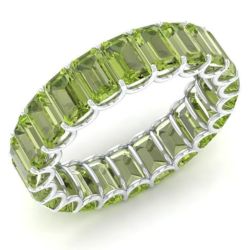
|
| Click on the Image |
Table Of Contents
- 1) What Is Peridot Gem?
- 1.a) The Origins of Peridot.
- 1.b) Chemical Composition and Structure.
- 1.c) Historical Significance of Peridot Gem.
- 2) What Are the Unique Properties of Peridot Gem?
- 2.a) Color Variations in Peridot.
- 2.b) Physical and Optical Characteristics.
- 2.c) Durability and Care.
- 3) Where Can You Find A Peridot
- 3.a) Prominent Mining Locations.
- 3.b) Rare and Exotic Sources.
- 3.c) Environmental Formation of Peridot.
- 4) How to Identify Authentic Peridot Gems?
- 4.a) Peridot vs. Imitations.
- 4.b) Key Indicators of Genuine Peridot Gem.
- 4.c) Certification and Provenance.
- 5) Why Choose Peridot Gem for Jewelry?
- 5.a) Versatility of Peridot Gem in Jewelry Designs.
- 5.b) Affordability and Availability.
- 5.c) Symbolism and Special Occasions.
- 6) How to Care for and Preserve Peridot Jewelry?
- 6.a) Cleaning and Maintenance Tips.
- 6.b) Protecting Peridot Gem from Damage.
- 6.c) Prolonging Peridot’s Longevity.
- 7) Fascinating Facts and Myths About Peridot Gem.
- 7.a) Historical and Cultural Beliefs.
- 7.b) Peridot in Modern Culture.
- 7.c) Record-Breaking Peridot Gems.
- 8) Peridot Gem In a Nutshell.
- 9) Conclusion.
|
|
1) What Is Peridot Gem?Back To Top |
Peridot is a stunning green gemstone formed deep within the Earth’s mantle. Its vibrant hues and unique origin make it highly sought after for jewelry. Ancient cultures cherished this gem for its beauty and spiritual significance. Today, it continues to captivate gem enthusiasts and collectors alike.
|
|
1.a.) The Origins of PeridotBack To Top |
Peridot originates from intense geological activity occurring beneath the Earth’s surface. Its formation requires the perfect combination of heat and pressure within the mantle. This gemstone occasionally arrives on Earth through extraterrestrial sources, adding a celestial touch to its allure.
The Natural Formation Of Peridot Deep Within The Earth’s Mantle
Deep beneath the crust, molten rock rich in magnesium and iron creates the ideal conditions for Peridot to form. As the mantle’s high temperatures and pressure act upon these minerals, crystals of olivine emerge. These olivine crystals, once transformed into gem-quality Peridot, remain hidden in the mantle until they are brought to the surface.
Green Peridot Gem Solid 14K White Gold Engagement Wedding Diamond Promise Ring |
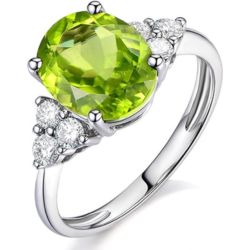
|
| Click on the Image |
Volcanic eruptions serve as nature’s delivery system, transporting Peridot from its underground birthplace to accessible locations on the surface. These eruptions often create lava flows that contain nodules of Peridot, making the gem a treasure born of fiery origins.
How Volcanic Activity And Meteorites Bring Peridot To The Surface
Volcanic eruptions act as natural elevators, bringing Peridot from the Earth’s depths to the surface. These eruptions carry magma filled with olivine crystals, which cool and solidify as they reach the crust. In regions with rich volcanic activity, such as Arizona and Hawaii, Peridot becomes accessible for mining.
Interestingly, Peridot also arrives from beyond Earth. Some specimens originate in pallasite meteorites, which contain gem-quality olivine crystals. These rare extraterrestrial gems are a testament to Peridot’s remarkable connection to both our planet and the cosmos.
|
|
1.b.) Chemical Composition and Structure Of Peridot GemBack To Top |
Peridot belongs to the olivine group, specifically the forsterite-fayalite series. Its unique chemical makeup, rich in magnesium and iron, gives the gem its signature green hue. Unlike other gemstones, Peridot’s color is an intrinsic property of its structure rather than an impurity.
Olivine Group Classification The Role Of Forsterite And Fayalite
Peridot forms from the mineral olivine, which is part of the forsterite-fayalite series. This series represents a spectrum of olivine compositions, ranging from magnesium-rich forsterite to iron-rich fayalite. Peridot gems typically lean closer to the forsterite end, as magnesium enhances the gem’s desirable green hue.
Fayalite, on the other hand, has higher iron content, which produces brown or yellowish tones. These less vibrant colors are less suitable for gem-quality Peridot, making forsterite-dominant stones the most prized in the jewelry market.
How Iron Content Gives Peridot Its Signature Green Color
Iron plays a central role in creating Peridot’s vibrant green shades. As an essential element in its chemical structure, iron contributes directly to the gem’s color. When present as ferrous iron (Fe2+), it produces vivid green tones, while ferric iron (Fe3+) adds yellow hues.
1.45 Ct. Peridot Gemstone & Black Diamond Ring in 10k Gold |
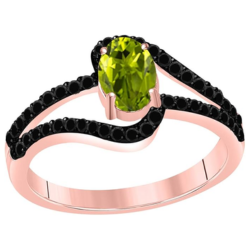
|
| Click on the Image |
The ideal Peridot Gem color balances iron content to achieve a bright, glowing green without muddiness. Stones with minimal impurities and the right proportion of iron are the most sought after, offering a dazzling visual appeal.
|
|
1.c.) Historical Significance of PeridotBack To Top |
Peridot has a rich history, deeply woven into ancient cultures and civilizations. From the Egyptians who called it the “gem of the sun” to medieval Europeans who revered its protective properties, Peridot has long been associated with light and protection.
Ancient Mining On Zabargad Island And Its Link To Egyptian Mythology
Zabargad Island, located in the Red Sea, holds the distinction of being one of the earliest known sources of Peridot. Ancient Egyptian miners braved treacherous conditions to unearth the gemstone, which they believed carried divine power. The island, often shrouded in mist, was thought to be blessed by the gods, further adding to Peridot’s mystique.
Egyptians treasured Peridot for its vibrant green color, associating it with Ra, the sun god. They believed it could protect wearers from evil spirits, particularly when set in gold. These gems adorned royal jewelry and ceremonial artifacts, emphasizing their value and significance.
Peridot’s Cultural And Spiritual Value Across Civilizations
Throughout history, Peridot has held a special place in various cultures. The Greeks admired its luminous glow, referring to it as a “golden stone.” In medieval times, people thought Peridot could ward off nightmares and bring good fortune.
Womans White Gold Green Triangle Peridot Delicate Wedding Band |
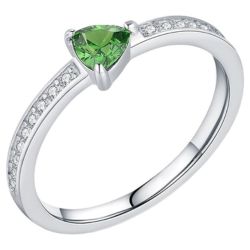
|
| Click on the Image |
Peridot also found its way into religious artifacts, such as the 200-carat gems on the Cologne Cathedral’s shrine. For centuries, these stones were mistaken for emeralds, a testament to their striking beauty. Even today, Peridot symbolizes prosperity, protection, and the enduring power of light.
|
|
2) What Are the Unique Properties of Peridot Gem?Back To Top |
The Olive Green Gemstone is cherished for its vibrant color, distinctive optical traits, and moderate durability. Its unique properties make it an appealing choice for jewelry lovers and collectors. Understanding these features helps you appreciate its natural beauty and care for it properly.
|
|
2.a.) Color Variations in PeridotBack To Top |
Peridot’s colors range from a warm yellow-green to a deep olive green, with pure green being the rarest. Trace elements, particularly iron, determine the exact hue and saturation of this Lime Green Jewel. These natural variations add to its charm, giving each stone a one-of-a-kind appearance.
Exploring The Shades From Yellow-Green To Olive To Pure Green
The Peridot Gemstone exhibits a spectrum of green shades depending on its mineral composition. Yellowish-green tones dominate the gemstone’s palette and are most commonly seen in jewelry. Olive green hues, often enriched by higher iron content, are equally stunning and provide a more earthy aesthetic.
Pure green Peridots, although rare, are highly sought after by collectors. These stones, free of brown or yellow undertones, boast a vibrant and intense brilliance. The interplay of light within these gems further enhances their natural allure, making them ideal for fine jewelry.
How Trace Elements Influence Peridot’s Brilliance And Saturation
The vivid green hues of this August Birthstone are primarily attributed to iron, a key element in its structure. Ferrous iron (Fe2+) contributes to the rich green tones, while ferric iron (Fe3+) introduces yellow hues that soften the intensity. A delicate balance of these elements determines whether a Peridot leans toward lime, olive, or yellow-green shades.
33.90 Carat Green Peridot Loose Gemstone Cushion Cut |
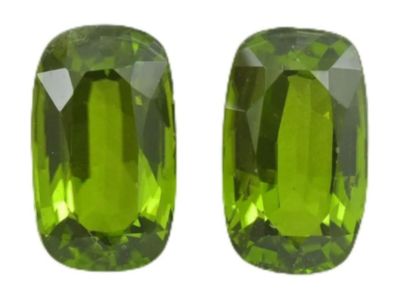
|
| Click on the Image |
The gem’s brilliance is further influenced by the stone’s clarity. High-quality specimens, free from visible inclusions, allow light to pass through unimpeded, creating a radiant sparkle. Stones with minimal inclusions and balanced trace elements command higher value in the market.
|
|
2.b.) Physical and Optical CharacteristicsBack To Top |
Peridot stands out for its strong birefringence and distinctive inclusions, which contribute to its unique visual appeal. These features make it easily distinguishable from other green gemstones. Its moderate specific gravity further aids in identification and adds to its charm as an Olivine Gemstone.
Birefringence And Its Doubling Effect In Peridot Facets.
One of the defining traits of Peridot is its strong birefringence, which causes light to split into two paths as it passes through the gem. This creates a “doubling” effect, where you may notice duplicate images of the stone’s facets under magnification. This optical property enhances the gem’s depth and adds a subtle sparkle, especially in well-cut stones.
The doubling effect can also serve as a helpful tool for gemologists when identifying genuine Peridot. While this phenomenon enhances its visual appeal, it requires careful cutting to ensure the doubling doesn’t detract from its beauty.
Specific Gravity And Inclusions: Identifying “Lily Pad” Patterns.
Peridot typically exhibits a specific gravity of 3.3 to 3.4, which is moderate compared to other gemstones. This property helps experts distinguish it from simulants like green glass or cubic zirconia.
| Natural Dainty Peridot Gemstone Beads Stretchble Crystal Healing Energy Stone Bracelet |
|---|
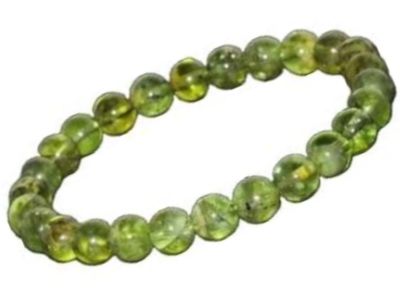
|
| Click on the Image |
Another hallmark of Peridot is its characteristic inclusions, known as “lily pad” patterns. These disk-shaped liquid-and-gas inclusions often form around tiny mineral crystals within the gem. While visible under magnification, these inclusions rarely affect the gem’s overall transparency and can even add to its individuality.
|
|
2.c.) Durability and CareBack To Top |
Although beautiful, Peridot is moderately durable, with a Mohs hardness of 6.5 to 7. Proper care and maintenance are essential to preserve the brilliance of this Volcanic Gemstone. By taking precautions, you can ensure your jewelry remains dazzling over time.
The Mohs Hardness Of Peridot And Its Sensitivity To Scratches.
Peridot’s hardness places it above softer stones like opals but below more resilient gems like sapphires. While it can resist everyday wear to some extent, it remains vulnerable to scratches from harder materials, including household dust containing quartz particles.
Its toughness is also limited, meaning it can fracture under heavy impact or pressure. For this reason, Peridot jewelry is best suited for occasional wear or protective settings, such as pendants or earrings, which are less likely to experience rough handling.
Best Practices For Cleaning And Maintaining Peridot Jewelry.
Cleaning your Lime Green Jewel properly is vital to maintaining its sparkle. Avoid harsh cleaning methods like ultrasonic or steam systems, which can damage the gem. Instead, use a soft brush with mild detergent and warm water to gently remove dirt and oils.
10K White Gold Green Peridot Gemstone Dangle Earrings For Women, August Birthstone |
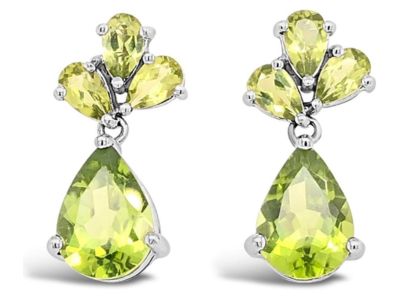
|
| Click on the Image |
When not in use, store Peridot jewelry in a separate compartment to prevent scratches from harder gemstones. You can also wrap it in a soft cloth for added protection. These simple steps help keep your Peridot looking as brilliant as the day you acquired it.
|
|
3) Where Can You Find A Peridot?Back To Top |
Peridot, known for its vibrant green hues, is sourced from both common and rare locations worldwide. Its origins range from volcanic sites to meteorites, offering a fascinating blend of terrestrial and extraterrestrial history. Understanding where Peridot forms helps highlight its unique characteristics and diverse appeal.
|
|
3.a.) Prominent Mining LocationsBack To Top |
The San Carlos Apache Reservation in Arizona is the world’s leading source of Peridot. Myanmar and Zabargad Island produce distinctive stones, offering unique hues and sizes that captivate collectors. These locations remain integral to the supply of high-quality Olive Green Gemstones.
San Carlos Apache Reservation: The World’s Largest Peridot Supply.
The San Carlos Apache Reservation in Arizona contributes up to 95% of the global Peridot supply. Here, tiny nodules of this Lime Green Jewel are found in basaltic rock, often forming grains smaller than five carats. Occasionally, larger stones are discovered, showcasing exceptional brilliance and clarity.
The Peridot mined here exhibits a yellow-green hue, which is highly favored for its vibrant and consistent coloring. As a reliable and abundant source, this location ensures that Peridot remains accessible to jewelry lovers across the globe.
Myanmar And Zabargad Island: Unique Hues And Crystal Sizes.
Myanmar’s Peridot mines near Mogok yield some of the largest and most intensely colored stones. These Volcanic Gemstones, often rich in green and free of yellow undertones, are considered premium quality. Some gems from Myanmar weigh hundreds of carats, making them extraordinary collector’s items.
14k Gold 3 Carat 6.5MM Princess Cut Lab Created Peridot Solitaire Stud Earrings |
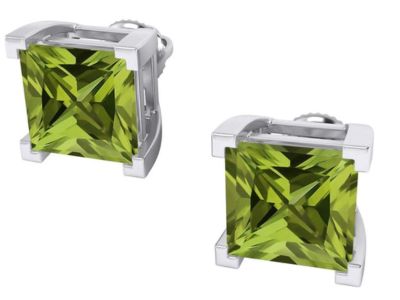
|
| Click on the Image |
Zabargad Island, off Egypt’s coast, is one of the oldest known sources of Peridot. Historically called the “Zabargad Treasure,” this site produces stones with a rich, medium-green color. These gems hold significant historical and cultural value, having been mined since ancient Egyptian times.
|
|
3.b.) Rare and Exotic SourcesBack To Top |
Meteorite Peridots are among the rarest gemstones, with a celestial origin that adds to their allure. Additionally, deposits in Pakistan, China, and Ethiopia have emerged as valuable sources for high-quality stones. These locations produce unique shades and crystal sizes that diversify the Peridot market.
Meteorite Peridots: Gemstones From Outer Space.
Meteorite Peridots, extracted from pallasite meteorites, are incredibly rare. These extraterrestrial gems offer a glimpse into the formation of olivine in outer space. Found only in a limited number of meteorites, they stand apart as a unique and fascinating category of August Birthstone.
The vibrant green crystals within these meteorites often display exceptional clarity. While rare in jewelry, their cosmic origin makes them a prized addition for gem collectors and enthusiasts alike.
Emerging Deposits In Pakistan, China, And Ethiopia.
Pakistan’s mountainous Kashmir region has become a renowned source of striking Peridot. These stones, often referred to as “Kashmir Peridot,” boast exceptional clarity and a pure green hue. The discovery of these deposits in the 1990s reignited global interest in this Yellowish-Green Gem.
Natural Peridot August Birthstone Teardrop Pendant Necklace in 14K Solid Gold |
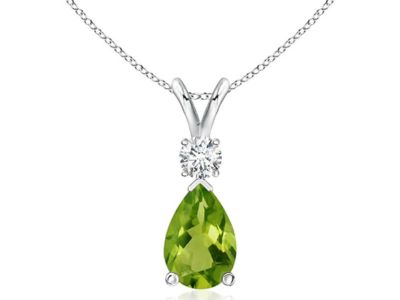
|
| Click on the Image |
China and Ethiopia have also emerged as producers of gem-quality Peridot. Chinese stones are known for their bright lime-green color, while Ethiopian gems offer earthy olive tones. Together, these regions expand the diversity and availability of Peridot worldwide.
|
|
3.c.) Environmental Formation of PeridotBack To Top |
Peridot forms in unique geological environments, often in peridotite rocks found in the Earth’s mantle. The movement of tectonic plates and volcanic activity plays a vital role in bringing this Golden-Hued Chrysolite to the surface. Understanding its formation highlights its connection to Earth’s natural processes.
Peridotite Rocks And The Spreading Of The Seafloor.
Peridotite, a dense igneous rock rich in olivine, is the birthplace of Peridot. This rock forms deep within the mantle and is occasionally brought to the surface through tectonic activity. As the seafloor spreads, mantle rocks rise, creating conditions for the crystallization of this Lime Green Jewel.
Deposits of Peridotite are found in regions with volcanic or tectonic activity, making locations like Arizona, Myanmar, and Zabargad ideal for gem mining. These processes give Peridot its unique blend of color and clarity.
Geological Processes That Make Peridot Unique Among Gemstones.
The geological history of Peridot sets it apart from other gems. Volcanic eruptions transport molten olivine to the surface, where it cools and solidifies into gem-quality crystals. This process often results in nodules encased within volcanic rock, making extraction a precise endeavor.
In some cases, tectonic movements alter and expose mantle rocks, bringing Peridot-bearing materials closer to the surface. These natural processes not only define the gem’s origins but also contribute to its rarity and beauty as a prized Olive Green Gemstone.
|
|
4) How to Identify Authentic Peridot GemsBack To Top |
Identifying authentic Peridot ensures you get genuine value and quality for your investment. By recognizing its unique properties and distinguishing it from imitations, you can confidently choose a true Olive Green Gemstone. Certification and expert verification further safeguard your purchase.
|
|
4.a.) Peridot vs. ImitationsBack To Top |
Imitations of Peridot, such as green glass or synthetic materials, can look deceptively similar. Understanding the physical and optical properties of this Yellowish-Green Gem helps set it apart from substitutes. Careful observation and testing ensure you select an authentic gem.
Distinguishing Peridot From Emeralds, Demantoid Garnets, And Green Glass.
Peridot’s lime-green hues often resemble other gemstones like emeralds and demantoid garnets. However, Peridot displays strong birefringence, creating a doubling effect in its facets. Neither emeralds nor garnets exhibit this feature, making it a key identifier.
Green glass, another common imitator, lacks the specific gravity and refractive index of Peridot. Glass often appears too flawless and lacks the “lily pad” inclusions typical of genuine Peridot. Observing these characteristics under magnification can help you differentiate between real gems and lookalikes.
Peridot Simulants: Synthetic Spinel, Corundum, And Cubic Zirconia.
Synthetic materials like spinel and corundum mimic Peridot’s vibrant color but differ in their physical properties. These simulants often lack the inclusions or optical traits of natural Peridot. Cubic zirconia, while similar in appearance, has a higher refractive index, making its sparkle more intense and distinct from Peridot’s natural brilliance.
Using gemological tools, you can quickly identify these differences. Reputable sellers should disclose if a gem is a simulant, but knowing what to look for ensures you can verify authenticity independently.
|
|
4.b.) Key Indicators of Genuine Peridot GemBack To Top |
Authentic Peridot often features distinct inclusions and optical characteristics that make it recognizable. By understanding these natural features, you can confidently distinguish it from imitations and low-quality gems.
Common Inclusions Such As “Lily Pad” Patterns.
One hallmark of genuine Peridot is the presence of “lily pad” inclusions. These disk-like inclusions form when gas or liquid becomes trapped during the crystal’s growth. Typically, these patterns surround tiny crystals of spinel or other minerals.
While these inclusions are visible under magnification, they rarely affect the gem’s overall clarity. Instead, they provide a unique fingerprint that confirms the gem’s natural origin. Familiarity with this trait is invaluable for spotting genuine Peridot.
Testing For Double Refraction And Other Optical Properties.
Peridot’s strong birefringence creates a doubling effect, which is a key feature of its optical properties. When viewed under magnification, this effect makes the facets appear duplicated, adding depth and sparkle to the gem.
Testing for refractive index and specific gravity further confirms authenticity. These measurements distinguish Peridot from imitations like green glass or cubic zirconia, which lack similar optical behavior. With these tests, gemologists can verify the quality and origin of your Olive Green Gemstone.
|
|
4.c.) Certification and ProvenanceBack To Top |
Certification from reputable sources guarantees the authenticity and quality of your Peridot. Provenance documentation, which details the gem’s origin, adds additional confidence to your purchase. Both factors play a critical role in ensuring you acquire an authentic Lime Green Jewel.
The Importance Of Obtaining Certified Peridot From Reputable Sources.
Purchasing certified Peridot ensures you receive a genuine gem with documented authenticity. Certificates often include details such as weight, dimensions, and any notable inclusions. Reputable sources also disclose whether a gem has undergone treatments, helping you make an informed decision.
Certification not only safeguards your investment but also provides valuable proof of authenticity. It’s especially important for larger or high-value stones where provenance significantly impacts their market value.
Using Gemological Tools To Verify Origin And Authenticity.
Gemological tools, such as refractometers and microscopes, allow for detailed analysis of Peridot’s physical traits. These tools measure specific gravity, refractive index, and inclusions, offering definitive evidence of a gem’s origin.
Verifying a gem’s authenticity through professional evaluation eliminates doubts. By combining certification with expert analysis, you can ensure your Volcanic Gemstone is genuine and worthy of your collection.
|
|
5) Why Choose Peridot Gem for Jewelry?Back To Top |
The Peridot Gem offers beauty, versatility, and a rich history that make it a captivating choice for jewelry. Its vibrant green hues complement various styles and settings, from casual to formal. Choosing this August Birthstone means embracing a gemstone with symbolic and aesthetic value.
|
|
5.a.) Versatility of Peridot Gem in Jewelry DesignsBack To Top |
Peridot shines in many types of jewelry, including rings, pendants, and earrings. Its lime-green hue adds a pop of color that blends well with modern and vintage designs. This flexibility ensures that Peridot remains a timeless choice for diverse fashion preferences.
Popular Settings For Rings, Pendants, And Earrings.
The bright green sparkle of Peridot makes it an eye-catching centerpiece for rings. Paired with diamonds or set in simple bands, its vivid color stands out beautifully. Pendants and earrings featuring this Olive Green Gemstone create elegant, wearable accessories for both daily and special occasions.
Its versatility allows jewelers to craft designs ranging from minimalist to ornate. Whether showcased in a classic prong setting or an intricate vintage design, Peridot adds a fresh and lively energy to any jewelry collection.
How Peridot Complements Modern And Vintage Aesthetics.
Peridot’s striking green color pairs effortlessly with modern metals like white gold and platinum. Its clean and vibrant tones work well with contemporary minimalist styles, making it a popular choice for trendy jewelry.
At the same time, this Lime Green Jewel harmonizes beautifully with vintage designs. When paired with yellow gold or filigree settings, Peridot evokes a timeless charm that resonates with lovers of classic styles. This adaptability ensures its appeal to a wide audience.
|
|
5.b.) Affordability and AvailabilityBack To Top |
Peridot offers a stunning alternative to pricier green gemstones like emeralds. Its wide availability and range of sizes, colors, and clarity make it accessible for various budgets. This affordability ensures that high-quality Peridot remains within reach for most buyers.
Comparing Peridot’s Value To Other Green Gemstones Like Emeralds.
While emeralds are highly prized for their deep green tones, Peridot provides an affordable option with its lime-green brilliance. Its lower price point allows buyers to choose larger stones or higher-quality gems for the same investment.
Additionally, Peridot’s natural clarity often surpasses that of emeralds, which tend to have more inclusions. This makes Peridot a fantastic choice for those seeking a clean and vibrant gemstone at a fraction of the cost.
The Wide Price Range Based On Size, Clarity, And Color Quality.
Peridot’s price varies depending on factors like size, clarity, and color intensity. Smaller stones or those with yellowish tones typically cost less, while larger gems with rich green hues command higher prices.
Despite this range, even premium-quality Peridot remains more affordable than many other gemstones. This balance of beauty and value makes it an appealing option for jewelry enthusiasts.
|
|
5.c.) Symbolism and Special OccasionsBack To Top |
Peridot’s connection to light and energy makes it meaningful for August birthdays and anniversaries. As a symbol of prosperity and protection, it holds cultural significance in various traditions. Its unique appeal extends beyond aesthetics, adding a personal touch to special occasions.
Why Peridot Is Ideal For August Birthdays And 16th Anniversaries.
As the official August Birthstone, Peridot symbolizes warmth, growth, and vitality. Its glowing green tones reflect the vibrant energy of summer, making it a fitting gift for August-born individuals.
Peridot also holds a special place as the traditional gemstone for 16th wedding anniversaries. Its association with renewal and harmony makes it a thoughtful and symbolic choice to celebrate enduring love.
Cultural Meanings And Myths Surrounding Peridot’s “Light” Energy.
Throughout history, Peridot has been linked to light and protection. Ancient Egyptians called it the “gem of the sun,” believing it could ward off darkness and evil spirits. This rich symbolism adds a deeper meaning to its natural beauty.
Legends across cultures attribute Peridot with bringing good fortune and inner peace. Its bright, cheerful energy resonates with wearers, making it more than just a beautiful stone—it becomes a source of inspiration and positivity.
|
|
6) How to Care for and Preserve Peridot JewelryBack To Top |
Proper care ensures your Peridot jewelry maintains its brilliance and remains free from damage. Avoiding harsh cleaning methods and practicing safe storage are key steps in preserving this Lime Green Jewel. By taking a few precautions, you can enjoy your Peridot’s beauty for years.
|
|
6.a.) Cleaning and Maintenance TipsBack To Top |
Mechanical cleaning methods can harm Peridot’s delicate structure, leading to fractures or loss of brilliance. Instead, using gentle cleaning techniques like warm water and mild detergent keeps your gem safe. Regular care prevents buildup, keeping this Olive Green Gemstone sparkling.
Why Mechanical Cleaning Methods Should Be Avoided.
Peridot is sensitive to ultrasonic and steam cleaning systems due to its moderate hardness and potential inclusions. High-frequency vibrations or extreme heat can weaken the stone, causing it to crack or lose its luster.
These cleaning methods may seem convenient, but they are unsuitable for preserving your Yellowish-Green Gem. Protecting its natural beauty requires gentler alternatives that avoid harsh treatments or abrasives.
Safe Ways To Clean Peridot Using Mild Detergent And Warm Water.
The safest way to clean Peridot jewelry involves warm water, a mild detergent, and a soft brush. Mix the detergent with water to create a gentle solution, then lightly scrub the gem to remove oils and dirt.
Rinse thoroughly under lukewarm water to ensure no residue remains. Pat the piece dry with a soft cloth, avoiding abrasive materials that could scratch the surface. This simple routine keeps your Volcanic Gemstone looking fresh and vibrant.
|
|
6.b.) Protecting Peridot Gem from DamageBack To Top |
Peridot is prone to scratches and fractures if exposed to harsh conditions. Protecting it from chemicals, rough handling, and extreme temperatures ensures its longevity. Proper storage also prevents unnecessary wear and tear.
The Risks Of Exposure To Acids, Scratches, And Extreme Heat.
Acids in everyday substances, including sweat and cleaning agents, can dull Peridot’s surface over time. Scratches occur easily if the gem comes into contact with harder materials, such as quartz or diamonds.
Extreme heat also poses a threat, as it can alter the gem’s clarity and color. To avoid damage, remove your Lime Green Jewel before engaging in activities like cooking, cleaning, or exercising.
Ideal Storage Solutions To Prevent Fractures And Scratches.
Store Peridot jewelry in a soft cloth pouch or a separate compartment of your jewelry box. Keeping it away from harder gemstones prevents scratches caused by contact.
If you own multiple pieces of jewelry, avoid stacking them together. Wrapping each piece individually provides extra protection, ensuring your Peridot retains its brilliance. Proper storage is as important as regular cleaning for maintaining this Olive Green Gemstone.
|
|
6.c.) Prolonging Peridot’s LongevityBack To Top |
Wearing Peridot occasionally and using protective settings help maintain its sparkle and structural integrity. Taking small precautions allows you to enjoy your August Birthstone without worrying about wear.
Occasional Wear Advice For Maintaining Brilliance.
Frequent exposure to rough conditions can diminish Peridot’s shine and durability. Consider reserving it for special occasions rather than everyday wear, especially in rings or bracelets that endure more impact.
When wearing your Lime Green Jewel, be mindful of activities that could subject it to stress. Avoid direct exposure to chemicals or abrasive surfaces to keep it looking its best.
The Role Of Protective Settings In Keeping Peridot Secure.
Choosing protective settings, such as bezel or halo designs, minimizes the risk of damage to your Peridot. These settings surround the gem, shielding it from direct contact with hard surfaces.
Rings and bracelets with raised settings offer additional protection, making them safer for occasional wear. By combining thoughtful design with proper care, you can enjoy the timeless beauty of this Yellowish-Green Gem for many years.
|
|
7) Fascinating Facts and Myths About Peridot GemBack To Top |
Peridot is more than just a stunning green gemstone—it’s steeped in history, culture, and myth. From ancient beliefs to record-breaking specimens, this gem has captured imaginations for centuries. Its enduring popularity makes it a fascinating addition to any jewelry collection.
|
|
7.a.) Historical and Cultural BeliefsBack To Top |
Throughout history, Peridot has been surrounded by fascinating lore and symbolism. Ancient Egyptians revered it as a “gem of the sun,” while other cultures believed it offered protection and prosperity. These stories add depth and intrigue to this Olive Green Gemstone.
Why Ancient Egyptians Called Peridot The “Gem Of The Sun.”
The ancient Egyptians associated Peridot with Ra, their powerful sun god. They believed its radiant green color captured the sun’s energy, making it a source of light and life.
Peridot mined from Zabargad Island was highly prized and often set in gold to amplify its luminous appearance. The Egyptians treasured this gem for its ability to dispel darkness and provide warmth, both physical and spiritual. This belief solidified its reputation as the “gem of the sun.”
Legends Of Peridot Warding Off Evil Spirits And Protecting Wearers.
Many cultures believed Peridot could guard against negative forces. Ancient texts described it as a protective stone that warded off evil spirits, particularly when set in gold or worn on the left arm.
This Lime Green Jewel was thought to bring its wearer peace and safety, even during times of uncertainty. Sailors carried it as a talisman to calm the seas and protect against storms. Such myths gave Peridot a unique position as a stone of protection and light.
|
|
7.b.) Peridot in Modern CultureBack To Top |
Peridot experienced a revival in modern times, thanks to new discoveries and renewed appreciation for its vibrant color. Today, it is a centerpiece in many jewelry collections, admired for its fresh, lively appeal.
Revival Of Peridot’s Popularity With New Discoveries In The 1990s.
In the 1990s, significant Peridot deposits were found in Pakistan’s Kashmir region. These discoveries introduced the market to exceptional stones with a pure green hue, often referred to as “Kashmir Peridot.”
This revitalized interest in the gem, leading to its resurgence in jewelry and gem collections worldwide. The increased availability allowed designers to experiment with fresh styles, propelling Peridot back into the spotlight.
How Peridot Is Featured In Contemporary Jewelry Collections.
Modern jewelers embrace Peridot for its versatile color and timeless charm. It frequently appears in rings, pendants, and earrings, often paired with diamonds or white metals like platinum.
Contemporary designs highlight its brilliance with minimalist settings, while vintage-inspired pieces bring out its classic elegance. Whether used in bold statement pieces or delicate accents, this Yellowish-Green Gem continues to shine in today’s jewelry trends.
|
|
7.c.) Record-Breaking Peridot GemsBack To Top |
Some Peridots stand out for their extraordinary size and brilliance, earning them places in prestigious collections. Here are some of the largest and most impressive peridot gems on record:
Smithsonian National Museum of Natural History: The largest known peridot gem, weighing 311.8 carats, is housed here. It originated from Zabargad Island (St. John’s Island) in Egypt.
Diamond Treasury, Moscow, Russia: An exquisite peridot gem weighing 192.75 carats.
Geological Museum, London, England: A peridot gem weighing 146 carats.
These gems are not only remarkable for their size but also for their stunning green hues and historical significance. Do you have a favorite gemstone, or are you just fascinated by peridots?
Details About The 311.8-Carat Smithsonian Peridot.
Housed in the Smithsonian Museum, this 311.8-carat Peridot is one of the largest faceted Peridots in the world. Its vibrant green hue and flawless clarity make it a truly awe-inspiring gem. Likely sourced from the legendary Zabargad Island, this specimen showcases the exceptional quality of Peridot from this historic location. Its impressive size and brilliance, achieved through expert cutting and polishing, highlight the gemstone’s potential and cement its status as a treasure of the natural world.
|
|
8) Peridot Gem In a NutshellBack To Top |
| In ancient times, the Egyptians extracted the peridot gem from Zabargad Island in the Red Sea, dubbing it the “sun gem” for its captivating yellow-green sparkle. Museums worldwide showcase these large, exquisite stones, highlighting their historical significance. Today, peridot remains a sought-after gem, celebrated for its soothing colors. We have access to stunning, vivid specimens and charming, smaller stones fitting a wide range of budgets. | |
| Mineral | Olivine |
|---|---|
| Chemical Composition | (MgFe)2SiO4 |
| Color | Yellowish green |
| Refractive Index | 1.65 to 1.69 |
| Birefringence | 0.035 to 0.038 |
| Specific Gravity | 3.34 |
| Mohs Hardness | 6.5 to 7 |
| Birthstones & Anniversaries | Peridot is designated as the birthstone of August and the gemstone of the fifteenth anniversary. |
| Treatments |
|
|
|
9) ConclusionBack To Top |
Peridot Gemstone combines beauty, history, and value, making it an exceptional choice for any jewelry collection. Its luminous green hues and symbolic significance ensure it remains a timeless treasure. Adding Peridot to your collection celebrates both elegance and affordability.
See More Gemstones As Follows